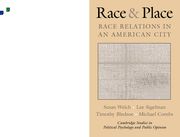Book contents
- Frontmatter
- Contents
- List of Figures
- List of Tables
- Preface
- 1 Introduction
- 2 Race Relations in Detroit, 1968–1992
- 3 Black–White Social Interaction
- 4 Perceptions of Racial Discrimination
- 5 Black Racial Solidarity
- 6 White Racial Prejudice
- 7 Opinions on Urban Issues: The Schools and the Police
- 8 Conclusions
- Appendix A The Detroit Surveys
- Appendix B Detroit Survey Items and Measures
- References
- Author Index
- Subject Index
- Miscellaneous Endmatter
7 - Opinions on Urban Issues: The Schools and the Police
Published online by Cambridge University Press: 05 June 2012
- Frontmatter
- Contents
- List of Figures
- List of Tables
- Preface
- 1 Introduction
- 2 Race Relations in Detroit, 1968–1992
- 3 Black–White Social Interaction
- 4 Perceptions of Racial Discrimination
- 5 Black Racial Solidarity
- 6 White Racial Prejudice
- 7 Opinions on Urban Issues: The Schools and the Police
- 8 Conclusions
- Appendix A The Detroit Surveys
- Appendix B Detroit Survey Items and Measures
- References
- Author Index
- Subject Index
- Miscellaneous Endmatter
Summary
Inadequate schools, drug addiction, crime, and poor housing have long been among the most familiar features of urban life in the United States. Unfortunately, our understanding of what the residents of urban areas think about these issues has been based largely on racial stereotypes – that blacks are dissatisfied with urban public services and consistently support more government spending to fix them and that whites are more satisfied and less favorable toward government spending.
In this chapter we explore blacks' and whites' attitudes about education and police protection, two of the most vexing problems in Detroit and across the nation. We expect the racial composition of the respondents' neighborhoods to emerge as important factors in shaping their views. Just as the neighborhood context influences attitudes about race, it also influences attitudes about how to deal with problems that are sometimes entangled with our views of race.
After exploring why we expect context to influence attitudes about these public services, we briefly examine national survey data on blacks' and whites' opinions on various urban policy issues and then probe more deeply into Detroit area residents' opinions about police and education.
THE IMPACT OF RESIDENCE ON ATTITUDES ABOUT PUBLIC SERVICES
In prior chapters, we have stressed the importance of neighborhoods as settings to build personal contact between blacks and whites. In turn, these contacts have had a modest effect on breaking down feelings of hostility and promoting interracial empathy.
- Type
- Chapter
- Information
- Race and PlaceRace Relations in an American City, pp. 124 - 155Publisher: Cambridge University PressPrint publication year: 2001



